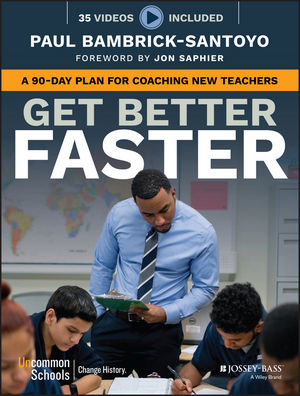08.08.16Review: Paul Bambrick’s Get Better Faster

Get Better Faster, by my colleague at Uncommon Schools Paul Bambrick-Santoyo, hit the shelves last week and now that I’ve had a chance to read it, I want to take a moment to recommend it highly.
It’s a book for leaders (at various levels of school organizations) but it focuses on one key task: developing and training teachers—young teachers in particular—a critical if sometimes unheralded part of leading schools.
This is critically important because, as he notes, the year in which each will-be-good-someday teacher is cutting his or her teeth and learning the craft is also the year some group of 100-odd students get their only shot at chemistry or 6th grade math or The Giver. “It may be their teacher’s first year of delivering instruction but it’s the students’ only year to learn the content,” Paul writes.
And of course failure in teaching—especially in the schools that serve the students of the greatest need–is endemic. And by failure I mean the profession’s failure to help the people who become teachers to succeed. 50% of new teachers in high need schools leave within three years. They take the job knowing the pay won’t be great and the conditions imperfect. But what they are not prepared for is to end everyday feeling beaten by the job. That barrier is nearly insurmountable.
So Paul’s topic—getting better faster—matters deeply to kids and to teachers alike, and thus of course to schools. We have to get it right. But in most schools it is left to chance and luck and circumstance- which is to say it doesn’t happen much. Good people are allowed to struggle and fail at the work and worthy kids pay the price.
The idea behind the book is that with intentionality and foresight—and knowledge gathered from teachers and leaders from around the country—schools can (and therefore should) be able to get teachers to be high functioning—positive orderly culture; rigorous lessons; strong relationships; effective real-time understanding of student proficiency–within 90 days.
If we can do that it’s a game changer.
As you’d expect from a Paul Bambrick book, it’s specific and actionable and nails the details.
Some of its strengths include:
- It includes a tested Scope and Sequence of what to do when with new teachers. This is probably the question I get most often about Teach Like a Champion. What to do first? Why? Honestly I try to provide guidance but not a strict sequence. “It depends on the teacher,” I say. And while that’s true it’s not that helpful. Paul, a veteran of training scores of teachers up in his schools has a clear and compelling rationale for what order and, what’s more, for what grain size. How much technique can people master at once while teaching? What dosage is too slow but what also will drown people? And what I like best about his Scope and Sequence is that it balances behavior/culture/management/relationship skills with rigor skills. The two things have to develop together and he nails that.
- It’s also outstanding on feedback, harnessing a lot of ideas we come to rely on in our own workshops and plenty of additional ones. His focus on making feedback actionable and specific is outstanding. He starts off the book with this reflection in fact:
Imagine if Nikki [principal] had instructed Jackson [new teacher] simply to “make sure your students are following your instructions.” That sounds like a straightforward direction, but in fact it’s fairly abstract. What does a teacher have to do to “make sure they’re following?”
Usefully, then, his book includes not only the skills teachers should learn but how what actions will accomplish them and what the key points of feedback to give are.
- And as he points out, “going into immense depth on one skill at a time, each building on the last, is precisely what makes…coaching effective. Pile on too many skills at once … the teacher will run out of both time and energy to internalize them.” You will socialize the teacher to expect training to not result in mastery and improvement. There’s a lifetime of that in most teachers first few years in the profession. No wonder they walk into professional development sessions with their arms folded, hoping to be left alone.
- This gets at another strength of the book. It details, in talking to leaders at such a granular level about how to give feedback and support development, how to build a culture that’s characterized by something like Carol Dweck’s growth mindset among the adults, and if there’s one thing this past year taught be it’s that the culture that surrounds and supports teacher development activities is at least as important as the content.
- Another favorite aspect of the book is the series of lessons from real life sidebars called, Findings from the Field and Quick Tip from a Coach. They’re small but trenchant reflections from school leaders and teachers about what made for success and they learned along the way—Jennifer Jackson of Denver Colorado reflecting on how real practice makes feedback less a judgment and more part of a shared endeavor; Thomas O’Brien of Brooklyn on the moment when he realized his goal was to get every student doing what the top students in the class were doing—they’re a pocketful of gems.
- And then of course there are the videos, not just of teaching but of leaders and teachers together, of the tools the leaders use to develop teachers and what it looks like in action. Those remarkable videos take the hidden world of teacher development and bring it into focus for perhaps the first time and offer to inform the craft of coaching as much as video of classroom instruction has transformed the craft of teaching.
